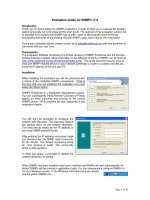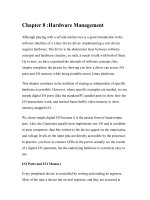Chapter 8 v7 0 accessible
Bạn đang xem bản rút gọn của tài liệu. Xem và tải ngay bản đầy đủ của tài liệu tại đây (2.63 MB, 134 trang )
Computer Networking: A Top Down
Approach
Seventh Edition
Chapter 8
Security in Computer
Networks
Copyright © 2017, 2013, 2010 Pearson Education, Inc. All Rights Reserved
Network Security
Chapter goals:
• understand principles of network security:
– cryptography and its many uses beyond
“confidentiality”
– authentication
– message integrity
• security in practice:
– firewalls and intrusion detection systems
– security in application, transport, network, link layers
Copyright © 2017, 2013, 2010 Pearson Education, Inc. All Rights Reserved
Learning Objectives (1 of 9)
8.1 What is network security?
8.2 Principles of cryptography
8.3 Message integrity, authentication
8.4 Securing e-mail
8.5 Securing TCP connections: SSL
0
8.6 Network layer security: IPsec
8.7 Securing wireless LANs
8.8 Operational security: firewalls and IDS
Copyright © 2017, 2013, 2010 Pearson Education, Inc. All Rights Reserved
What is Network Security?
confidentiality: only sender, intended receiver should
“understand” message contents
– sender encrypts message
– receiver decrypts message
authentication: sender, receiver want to confirm identity of each
other
message integrity: sender, receiver want to ensure message
not altered (in transit, or afterwards) without detection
access and availability: services must be accessible and
available to users
Copyright © 2017, 2013, 2010 Pearson Education, Inc. All Rights Reserved
Friends and Enemies: Alice, Bob, Trudy
• well-known in network security world
• Bob, Alice (lovers!) want to communicate “securely”
• Trudy (intruder) may intercept, delete, add messages
Copyright © 2017, 2013, 2010 Pearson Education, Inc. All Rights Reserved
Who Might Bob, Alice Be?
• … well, real-life Bobs and Alices!
• Web browser/server for electronic transactions
(e.g., on-line purchases)
• on-line banking client/server
• DNS servers
• routers exchanging routing table updates
• other examples?
Copyright © 2017, 2013, 2010 Pearson Education, Inc. All Rights Reserved
There are Bad Guys (and Girls) Out There!
Q: What can a “bad guy” do?
A: A lot! See section 1.6
– eavesdrop: intercept messages
– actively insert messages into connection
– impersonation: can fake (spoof) source address in
packet (or any field in packet)
– hijacking: “take over” ongoing connection by
removing sender or receiver, inserting himself in place
– denial of service: prevent service from being used
by others (e.g., by overloading resources)
Copyright © 2017, 2013, 2010 Pearson Education, Inc. All Rights Reserved
Learning Objectives (2 of 9)
8.1 What is network security?
8.2 Principles of cryptography
8.3 Message integrity, authentication
8.4 Securing e-mail
8.5 Securing TCP connections: SSL
8.6 Network layer security: IPsec
8.7 Securing wireless LANs
8.8 Operational security: firewalls and IDS
Copyright © 2017, 2013, 2010 Pearson Education, Inc. All Rights Reserved
The Language of Cryptography
m plaintext message
K A m ciphertext, encrypted with key K A
m = KB K A m
Copyright © 2017, 2013, 2010 Pearson Education, Inc. All Rights Reserved
Breaking an Encryption Scheme
• cipher-text only
attack: Trudy has
ciphertext she can
analyze
• two approaches:
– brute force:
search through all
keys
– statistical analysis
• known-plaintext
attack: Trudy has
plaintext corresponding
to ciphertext
– e.g., in
monoalphabetic
cipher, Trudy
determines pairings
for a,l,i,c,e,b,o,
• chosen-plaintext
attack: Trudy can get
ciphertext for chosen
Copyright © 2017, 2013, plaintext
2010 Pearson Education, Inc. All Rights Reserved
Symmetric Key Cryptography
symmetric key crypto: Bob and Alice share same
(symmetric) key: Ks
• e.g., key is knowing substitution pattern in mono
alphabetic substitution cipher
Q: how do Bob and Alice agree on key value?
Copyright © 2017, 2013, 2010 Pearson Education, Inc. All Rights Reserved
Simple Encryption Scheme
substitution cipher: substituting one thing for
another
• monoalphabetic cipher: substitute one letter for
another
e.g.:
Encryption key: mapping from set of 26 letters
to set of 26 letters
Copyright © 2017, 2013, 2010 Pearson Education, Inc. All Rights Reserved
A More Sophisticated Encryption Approach
• n substitution ciphers, M1,M2,…,Mn
• cycling pattern:
– e.g., n=4: M1,M3,M4,M3,M2; M1,M3,M4,M3,M2; ..
• for each new plaintext symbol, use subsequent
substitution pattern in cyclic pattern
– dog: d from M1, o from M3, g from M4
Encryption key: n substitution ciphers, and
cyclic pattern
– key need not be just n-bit pattern
Copyright © 2017, 2013, 2010 Pearson Education, Inc. All Rights Reserved
Symmetric Key Crypto: DES (1 of 2)
DES: Data Encryption Standard
• US encryption standard [NIST 1993]
• 56-bit symmetric key, 64-bit plaintext input
• block cipher with cipher block chaining
• how secure is DES?
– DES Challenge: 56-bit-key-encrypted phrase
decrypted (brute force) in less than a day
– no known good analytic attack
• making DES more secure:
– 3DES: encrypt 3 times with 3 different keys
Copyright © 2017, 2013, 2010 Pearson Education, Inc. All Rights Reserved
Symmetric Key Crypto: DES (2 of 2)
DES operation
initial permutation 16 identical
“rounds” of function
application, each using
different 48 bits of key final
permutation
Copyright © 2017, 2013, 2010 Pearson Education, Inc. All Rights Reserved
AES: Advanced Encryption Standard
• symmetric-key NIST standard, replaced DES (Nov
2001)
• processes data in 128 bit blocks
• 128, 192, or 256 bit keys
• brute force decryption (try each key) taking 1 sec
on DES, takes 149 trillion years for A ES
Copyright © 2017, 2013, 2010 Pearson Education, Inc. All Rights Reserved
Public Key Cryptography (1 of 2)
symmetric key crypto
public key crypto
• requires sender,
receiver know shared
secret key
• radically different approach
[Diffie-Hellman76, RSA78]
• Q: how to agree on
key in first place
(particularly if never
“met”)?
• sender, receiver do not
share secret key
• public encryption key
known to all
• private decryption key
known only to receiver
Copyright © 2017, 2013, 2010 Pearson Education, Inc. All Rights Reserved
Public Key Cryptography (2 of 2)
Copyright © 2017, 2013, 2010 Pearson Education, Inc. All Rights Reserved
Public Key Encryption Algorithms
requirements:
1. need kB+ . and k B- . such that
kB- kB+ (m) = m
2. given public key k B+ , it should be impossible to
compute private key k BRSA: Rivest, Shamir, Adelson algorithm
Copyright © 2017, 2013, 2010 Pearson Education, Inc. All Rights Reserved
Prerequisite: Modular Arithmetic
• x mod n = remainder of x when divide by n
• facts:
a mod n + b mod n mod n = a + b mod n
a mod n - b mod n mod n = a - b mod n
a mod n * b mod n mod n = a * b mod n
• thus
(a mod n)d mod n = ad mod n
• example: x=14, n=10, d=2:
(x mod n)d mod n = 42 mod 10 = 6
x d = 142 = 196 x d mod 10 = 6
Copyright © 2017, 2013, 2010 Pearson Education, Inc. All Rights Reserved









